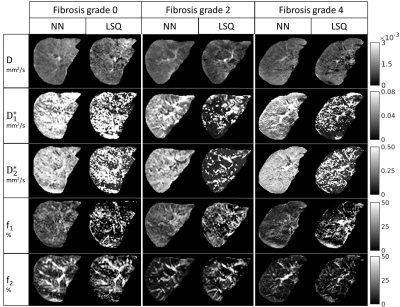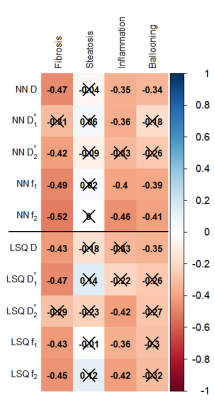Marian A. Troelstra1, Julia J. Witjes2, Anne-Marieke van Dijk2, Anne Linde Mak2, Jurgen H. Runge1, Joanne Verheij3, Max Nieuwdorp2, Adriaan G. Holleboom2, Aart J. Nederveen1, and Oliver J. Gurney-Champion1
1Department of Radiology and Nuclear Medicine, Amsterdam UMC, location AMC, Amsterdam, Netherlands, 2Department of Internal and Vascular Medicine, Amsterdam UMC, location AMC, Amsterdam, Netherlands, 3Department of Pathology, Amsterdam UMC, location AMC, Amsterdam, Netherlands
1Department of Radiology and Nuclear Medicine, Amsterdam UMC, location AMC, Amsterdam, Netherlands, 2Department of Internal and Vascular Medicine, Amsterdam UMC, location AMC, Amsterdam, Netherlands, 3Department of Pathology, Amsterdam UMC, location AMC, Amsterdam, Netherlands
In this study we successfully developed an
unsupervised physics informed deep neural network for fitting a tri-exponential
model to intravoxel incoherent motion data from non-alcoholic fatty liver
disease patients, creating clinically relevant high-quality parameter maps.

Fig.1. Tri-exponential IVIM fit of the liver using IVIM3-NET (NN) versus nonlinear least squares (LSQ) fit in three non-alcoholic fatty liver disease patients with progressive fibrosis grades. Parameters fit for both fit methods were diffusion (D), slow pseudo-diffusion (D*1), fast pseudo-diffusion (D*2), slow perfusion fraction (f1) and fast perfusion fraction (f2). The IVIM3-NET shows less noisy parameter map images when compared to LSQ-fit. Particularly for f2, a decrease in signal is visible as fibrosis levels increase.

Fig.2. Spearman correlations between histology and IVIM
parameters fitted using IVIM3-NET (NN) and nonlinear least squares
(LSQ) fit. Crossed out correlation coefficients represent non-significant
correlations, others all had a p-value < 0.05. While performance was
similar, the IVIM3-NET showed slightly more and stronger correlations between IVIM parameters and histology. Overall, fibrosis showed the most and strongest
correlations with IVIM parameters, followed by inflammation and ballooning
resp. Steatosis levels did not correlate with any IVIM parameters.